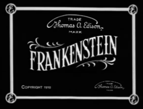 |
| Frankenstein (1910) film title frame |
Title: "Frankenstein"
Category: Movies
Subcategory: Horror
Director and screenwriter: James Searle Dawley
Based on: "Frankenstein" by Mary Shelley
Starring:
--- Augustus Phillips (Dr. Frankenstein)
--- Charles Ogle (the Monster)
--- Mary Fuller (Elizabeth)
--- Augustus Phillips (Dr. Frankenstein)
--- Charles Ogle (the Monster)
--- Mary Fuller (Elizabeth)
 |
| James Searle Dawley May 13, 1877 - March 30, 1949, director and screenwriter of Frankenstein |
Producer - Distributor: Edison Manufacturing Company
Released: March 18, 1910 - New York City, USA
Running time: 13 min.
Color: B/W, color
Language: Silent
Music by: Life Toward Twilight
Summary plot: Frankenstein, a young medical student, trying to create the perfect human being, instead creates a misshapen monster. Made ill by what he has done, Frankenstein is comforted by his fiancée but on his wedding night he is visited by the monster. A fight ensues but the monster, seeing himself in a mirror, is horrified and runs away. He later returns, entering the new bride's room, and finds her alone.
Interesting facts: For many years, this film was believed to be a lost film. In 1963, a plot description and stills were discovered published in the issue of an old Edison film catalog, "The Edison Kinetogram" (below). In the early 1950s a print of this film was purchased by a Wisconsin film collector, who did not realize its rarity until many years later. Its existence was first revealed in the mid-1970s.
Property: Edison Manufacturing Company
 |
Frankenstein on "The Edison Kinetogram" film catalog (cover, March 15, 1910) |
 |
Frankenstein on "The Edison Kinetogram" film catalog (clipping, March 15, 1910) |
 |
| Frankenstein announcement (The Film Index, New York City, March 5, 1910). «"Frankenstein," Mrs. Shelley's famous story, will be released by the Edison Company very soon. The possibilities of this weird tale from a dramatic and photographic standpoint are tremendous, and in their development the Edison people have set themselves to a task that will exhaust every resource at their command». |
 |
| Frankenstein announcement, plot and review (The Film Index, New York City, March 12, 1910). «"FRANKENSTEIN" Ambitious Effort of the Edison Producers Should Attract Widespread Attention - Other Releases. "Frankenstein," which will be released March 18, is a liberal adaption of Mrs. Shelley's famous story under that title. As told in the film story shows Frankenstein, a young student of the sciences, leaving his father and sweetheart to persue his studies at college. In the course of his researches he discovers the awful mystery of life and death and immediately determines to realize his one consuming ambition - to create the most perfect human being that the world has ever seen. Alone in his room he conducts the experiment and after an almost breathless suspense is rewarded by seeing an object forming and rising from the blazing caldron in which ha has poured his ingredients, - a vague, shapeless thing at first but gradually assumes a human form and exhibits sign of animation. His joy at the success of his experiment is quickly turned to horror and dismay, however, when he finally beholds the fruition of his labor; for the evil thoughts that swayed his mind before and during the experiment have so influenced his handwork that, instead of a human being endowed with beauty of face and form, he has created a hideous monster of a colossal, unshapely proportions and most frightful mien. The agony he endures in the days that succeed in trying to keep his awful secret from the world, and especially from his sweetheart as their wedding day draws near, is most realistically depicted upon the film. The monster, unwilling to be separated from his creator, haunts his footsteps with canine-like devotion, jealous of and resenting his attentions to any one else. The object of the creature's especial hatred is Frankenstein's sweetheart, whose room he invades on her wedding night, driving her shrieking into her husbands' arms. Broken down by his unsuccessful efforts to be constantly with his creator and appalled as well at his own reflection, the monster stands in an attitude of entreaty before the mirror and here the psychological theory of the whole story is demonstrated, viz: that when Frankenstein's love for his bride shall have attained its full strenght and freedom from impurity the creature cannot exist. The monster gradually fades from view, leaving only hid reflection in the glass, which strange to say remains as the reflection of Frankenstein himself as he enters the room and approaches the mirror. Gradually, however, under the influence of his now better love and nature the image of the monster disappears and Frankenstein, freed from the awful burden he has been carrying, finds happiness in his bride's embrace. The actually repulsive situations in the original version have been carefully eliminated in its visualized form, so that there is no possibility of its shocking any portion of an audience; but the dramatic strenght of this gruesome story clings to its dramatization, and it is safe to say that no film has ever been released that can surpass it in power to fascinate an audience. The scene in the laboratory in which the monster seemed to gradually assume human semblance is probably the most remarkable ever committed to a film. "Frankenstein" is a production that will hold an audience spellbound and is certain to excite a very great deal of attention and comment». |
Frankenstein (1910), complete film ready to play (13 min.) |
